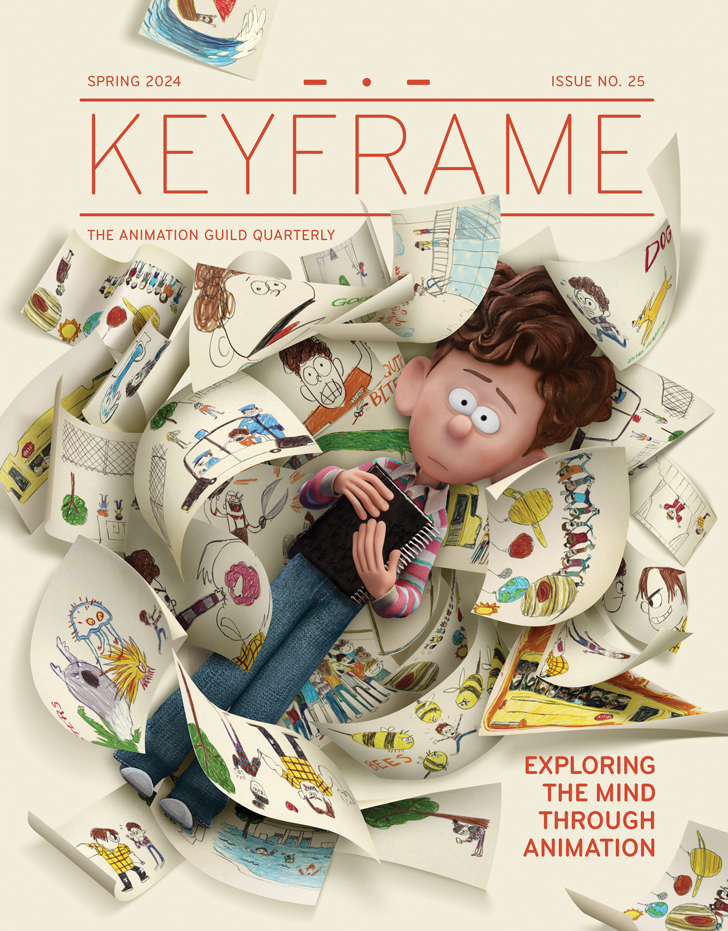To create his latest picture book, Pete Oswald faced down—and ultimately conquered—the ocean.
The Noise Inside Boys: A Story About Big Feelings is largely set at the beach. Which means that Oswald, a veteran Character Designer, Visual Development Artist, and Production Designer, needed to figure out how to depict water. As he was doing his sketches in black and white, he says, “In the back of my head I was going, oh my goodness, how am I going to pull this off? How am I going to make this water feel special?”

Spoiler alert: he found a way to do it.
Oswald studied animation and graphic design at Loyola Marymount University. Although he pursued a career in film and TV, he’s had a longstanding affection for picture books which he says influenced his career in animation.
“Although I’m always thinking about picture books, I never thought I would actually do them,” he says. It was a fun and enlightening moment when he realized how great it could be to work on both.
In The Noise Inside Boys, water represents more than just something you swim in. It tackles the oceans of emotions that boys are often conditioned not to feel or express.
“Be strong.” “Don’t cry.” “Let it go.” “Be a man.”
Sound familiar? It does to Oswald who has authored or illustrated several previous books. But this latest effort, which is dedicated to his three sons, had an especially personal element.

“I think there’s a problematic history of males not feeling comfortable with their emotional intelligence, and I just wanted this book to play a small role in changing that,” says Oswald whose credits include The Angry Birds movies, Cloudy with a Chance of Meatballs, and ParaNorman. “It started out as a poem I wrote for my sons, wanting to give them the space and permission to feel. I talked with my editor and my agent, and they agreed this could make a really timely and important picture book.”
In the story, during a day at the beach, the youngest boy is teased by his brother after a soccer ball destroys his sand castle. The incident mirrors something that actually happened to Oswald’s sons Vincent (11), William (10), and Anderson (4), who he says are a constant inspiration. Oswald works from his L.A. home, and his office is between the boys’ rooms, so they frequently peek in on what dad is up to. As Oswald notes, kids can be pretty honest in their assessments.

And while the book is based on a personal experience, Oswald hopes it has broad appeal. “It’s not just for boys. It’s for any human who has emotions,” he says.
For the illustrations, he worked in watercolors, scanning the images and painting digitally over the top. Since one never knows what the pigments are going to do, he says that the medium of watercolor can be a little unpredictable, but it worked for this project.
“You don’t how the water’s going to flow, and there’s this kind of happy accident which I love about watercolor because two brush strokes can never be exactly the same,” Oswald says. “I thought that was a really great relationship to the theme of the book, talking about emotions and how they flow in and out of us as humans.”
Oswald has played around in watercolors before, but not so much within his picture books. Getting to work on The Noise Inside Boys, he initially proceeded with caution, afraid to make a mistake because, as he noted, “There’s no undo button.” The more he progressed, the greater his confidence as he got into the work and saw how it was coming together.
For sections where the father talks about emotions, Oswald wanted the images to be monochromatic. But for the depictions of emotions, he had to give a lot of thought to color choices as they related to a given feeling, such as blue for sadness, green for envy, and red for anger.

Then there was the water itself. Oswald got a bunch of blank illustration boards and started throwing down loose watercolor washes. Once they were scanned, “I’d have little bits and pieces, and I could combine them digitally on multiple layers,” he says. He describes the title page, for example, where there was a swirl with a marble-esque aspect that also had a reflecting quality with an organic, tactile feel to it. “I was especially excited when I landed this stylized look of the water so I could carry it through the book.”
Growing up with an older brother and a younger half-brother, Oswald knew something about male emotions even before he had his own children. “Having that past and becoming a father myself and having sons, a lot of this book was the culmination of all those experiences,” he says.
His wife Allison, on the other hand, grew up in a household full of girls. “[She] has a lot to do with how I perceive myself and perceive males in general,” Oswald says, noting that this influenced different aspects of being open to talking about his emotions and dealing with his own mental wellness.
“I would say that 20 years ago, I didn’t know that mental wellness was an actual thing,” Oswald says. “Now the fact that we can have our four-year-old talk about different emotions and understand them—I think that’s one step closer to supporting children who are more resilient, better communicators, and hopefully better humans overall.”
Learn more about Oswald’s work at www.peteoswald.com.







.png)